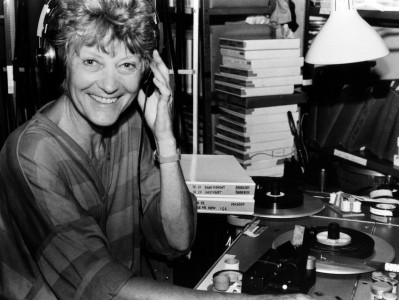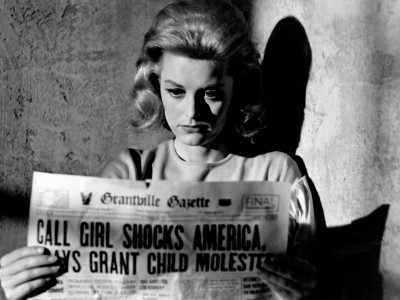
An incredibly prolific documentary filmmaker, Michael Blackwood spent his life crafting an indispensible archive of 20th century arts and architecture. Sometimes co-directed by his filmmaking brother Christian, Michael Blackwood's films cover all aspects of the influential products, people and processes of modern art creation.
Originally named Schwarzwald, Michael Blackwood (b.1934) and Christian (1942 - 1992) were born in Germany during Hitler's reign. Once the war began, the Schwarzwalds spent many horrific, chaotic years skirting death. Sheer luck, non-Jewish maternal grandparents, sympathetic gentiles, and their keen, resourceful mother all played parts in their survival. Finally, the family left a demolished Berlin in 1949 for a fresh start in Manhattan.
The brothers had been exposed to the innerworkings of film and art from birth; before the war, their parents ran a company that made materials for movie and theater sets. Beginning their cinematic careers at a young age, they both had auspicious starts in different fields: Christian as a child actor and later cinematographer (the first film he helped lens was Straub-Huillet's Not Reconciled [1965]), and Michael as an apprentice editor at NBC. The documentary work Michael edited at NBC's Special Film Unit led to his making his first film, Broadway Express (1959), a nineteen-minute cinema verité study of the New York subway. In the words of Richard Brody, "It’s a haunting, anecdotal cross-section of city life, and New York’s personalities seem to burst forth from the screen."
Moving back to Germany in 1959, Michael worked as a freelance director and producer of documentaries for West German television. Shortly after his return to the States in 1965, he and his brother formed Blackwood Productions, focused on documenting significant contemporary figures in the arts and humanities. Two of their earliest documentaries, Monk (1968) and Monk in Europe (1968), are detailed verité journals of several days in the life of Thelonius Monk. Portions of the thirteen hours of footage they shot is used in Charlotte Zwerin's Straight, No Chaser (1988).
Unlike Zwerin’s film, the Blackwoods’ documentary features nothing but their own footage of Monk and company on tour, at work, and in private—no added interviews, nobody else’s archival footage, no additional musicians’ performances, no voice-over commentary, no layering of illustrative newsreel footage or historical information to contextualize the concert tours that the brothers film. The result is something much more immersive. Where Zwerin sketches Monk’s life, the Blackwoods take you inside it.
Many films on many artists—directed either by one or both brothers—followed. These included monographs on individual artists such as Christo, David Hockney, Jim Dine, Isamu Noguchi, Philip Guston and Jasper Johns; surveys of groups or movements—for instance, Musical Outsiders: An American Legacy (1966), Japan: the New Art (1970), The New York School (1972), Tapdancin' (1980); as well as a variety of cultural icons: Roger Corman: Hollywood’s Wild Angel (1976), Edith Head (1981), All By Myself: The Eartha Kitt Story (1982), A Composer’s Notes: Philip Glass and the Making of an Opera (1985), to list but a few. While Christian's interests tended to move freely around the worlds of art, dance, music and film, Michael was more focused on well-known American painters, usually either Pop artists or Abstract Expressionists, though by the late 70s, he began veering from this course with films like Fourteen Americans: Directions of the 1970s (1980)—which featured emerging artists Joseph Kosuth, Laurie Anderson, Nancy Graves and Gordon Matta-Clark, among others—and the remarkably comprehensive Pablo Picasso: The Legacy of a Genius (1981), as well as an examination of New York in the 80s, Empire City (1985). Starting later that decade, Michael added numerous documentaries on architects and architecture, a passion that would continue for the rest of his career.
Not long after the brothers parted ways, forming two separate production companies in 1988, Christian died of lung cancer at age fifty. Most of his substantial archive of documentary work is included within both Michael Blackwood Productions and the HFA collection. Aside from those mentioned above, some of his unusual, complex subjects are featured in films such as, My Life for Zarah Leander (1986), Signed: Lino Brocka (1987) and Motel (1989), as well as his and Robert Leacock's astonishing portrait of New York's Upper West Side, Summer in the City (1971).
Michael's production continued unabated through 2014. A small sampling of the hundreds of artists he documented—Frank Gehry, Eva Hesse, Bruce Nauman, Sol LeWitt, Sally Gross, Gerhard Richter, Zaha Hadid, Cecil Balmond, Lee Ufan—reveals the breadth and depth of his devotion to a lifelong educational and artistic endeavor. And tucked within this overarching cultural document are ancillary epics; Michael revisited many artists at different points in their lives, often covering the expanse of entire careers. Shown regularly as part of arts education and in conjunction with retrospectives at museums and galleries around the world, the Blackwood oeuvre preserves the voices and works of 20th and 21st century artists in, as Michael notes, "a fusion of images and journalism." Without intervening, he simply elucidates the creative process and its output within the context of its time, in the artists', curators' and critics' own words.
I think his legacy will be shaped by the scale and scope, and significance, of his contribution to the documentation of the fields of art and architecture in particular, as well as documentary filmmaking as a whole. Specifically, his unique approach of featuring the subject in a focused and first-hand manner, without a script or even lighting, and by observing rather than orchestrating a production. He wanted to really provide the audience with direct access to these important subjects — something that isn’t experienced easily in any other medium or context. Michael was relatively specialized compared to many of his fellow documentary filmmakers, despite covering a wide range of subjects (both current and historic), and arguably unmatched in terms of overall prolificacy and focus. His objective was to amass a rich documentation that would democratize the arts and educate the viewer, standing up alongside written text for posterity.
About the Collection
The Michael Blackwood Collection at the Harvard Film Archive includes original 16mm negatives, video masters, 16mm prints, soundtracks and other pre-print materials.
The collection is searchable via HOLLIS.
For more information on the films, visit Michael Blackwood Productions. Many of the films are streamable on Vimeo, Kanopy and Amazon.
Additional Resources
"Michel Blackwood chronique filmique de l'art actuel," by René Rozon, Vie des arts, Vol. 25, No. 102, Spring 1981
"What to Stream: Rediscovering the Blackwood Brothers, A Pair of Great Documentarians of New York City Life," by Richard Brody, The New Yorker, May 2020
"Who Is Michael Blackwood?," Norton Museum of Art, November 2020
"Documentary Filmmaker Christian Blackwood," WHYY Fresh Air interview, 1990
"Berlin and New York: A Personal Involvement" by Michael Blackwood, Berlin-New York, Like and Unlike: Esssays on Architecture and Art from 1870 to the Present, Josef Paul Kleihues and Christina Rathgeber, eds., Rizzoli, New York, 1993















